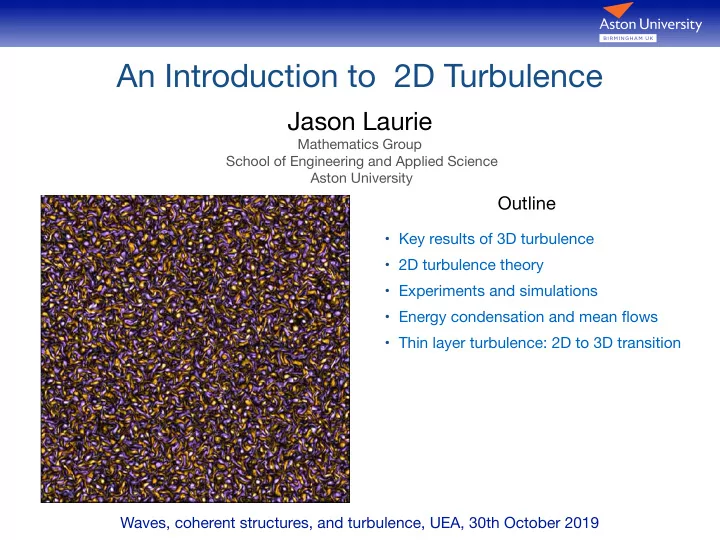

An Introduction to 2D Turbulence Jason Laurie Mathematics Group School of Engineering and Applied Science Aston University Outline • Key results of 3D turbulence • 2D turbulence theory • Experiments and simulations • Energy condensation and mean flows • Thin layer turbulence: 2D to 3D transition Waves, coherent structures, and turbulence, UEA, 30th October 2019
Why is 2D turbulence important? Mean flows in geophysical turbulence Thin-layer fluid experiments Sommeria, J. Fluid Mech. 170 , 139, (1986)
Why is 2D turbulence important? Mean flows in geophysical turbulence Thin-layer fluid experiments Properties • Stable large-scale coherent mean flow • Typically generated out of small-scale fluctuations • In non-equilibrium balance between forcing and dissipation
Navier-Stokes and turbulence 3D Navier-Stokes equations Claude-Louis Navier and George Stokes (1827-1845) ∂ t + ( v · r ) v = � 1 ∂ v ρ r p + ν r 2 v + f r · v = 0 Reynolds number Osbourne Reynolds (1883) • Ratio of the nonlinear advection term to Re ' 1 . 54 that of viscous di ff usion Increasing Re Re ' 26 Re = | ( v · r ) v | ⇠ V L Re ' 2000 | ν r 2 v | ν Turbulence appears when 1 ⌧ Re
<latexit sha1_base64="mMl1jBduDgEV0PwVS0BZMUwOkBk=">AB73icdVDLSgMxFM3UV62vqks3wSK4GjLTlpwUXDjsoJ9QDuUTJpQzPJmGSEMvQn3LhQxK2/486/MX0IKnrgwuGce7n3njDhTBuEPpzc2vrG5lZ+u7Czu7d/UDw8amuZKkJbRHKpuiHWlDNBW4YZTruJojgOe2Ek6u537mnSjMpbs0oUGMR4JFjGBjpW6fJpxKQbFEnJRreaX6xC5frlarXuWVKrIK3vQc9ECJbBCc1B87w8lSWMqDOFY656HEhNkWBlGOJ0V+qmCSYTPKI9SwWOqQ6yxb0zeGaVIYyksiUMXKjfJzIcaz2NQ9sZYzPWv725+JfXS010EWRMJKmhgiwXRSmHRsL583DIFCWGTy3BRDF7KyRjrDAxNqKCDeHrU/g/afuV3b9m0qpcbmKIw9OwCk4Bx6ogQa4Bk3QAgRw8ACewLNz5zw6L87rsjXnrGaOwQ84b5+tvJBh</latexit> <latexit sha1_base64="25Km1GaDAXduvhvibkSPUQKUTIE=">ACH3icbVDLSgMxFM34rPVdekmWARXZWYUdSMU3bisYB/Y1JLJZNrQTGZIMsUynT9x46+4caGIuOvfmD4W2nogcHLOvdx7jxdzprRtj6yl5ZXVtfXcRn5za3tnt7C3X1NRIgmtkohHsuFhRTkTtKqZ5rQRS4pDj9O617sZ+/U+lYpF4l4PYtoKcUewgBGsjdQunD/AK4gCiUnqZKmbISY0HCKBPY6RZiFVMEVeAPvZ8NF0J98nrJ2oWiX7AngInFmpAhmqLQL38iPSBJSoQnHSjUdO9atFEvNCKdZHiWKxpj0cIc2DRXYTG6lk/syeGwUHwaRNM+sN1F/d6Q4VGoQeqYyxLqr5r2x+J/XTHRw2UqZiBNBZkOChIOdQTHYUGfSUo0HxiCiWRmV0i62ISlTaR5E4Izf/Iiqbkl57Tk3p0Vy9ezOHLgEByBE+CAC1AGt6ACqoCAZ/AK3sGH9WK9WZ/W17R0yZr1HIA/sEY/NMyieg=</latexit> <latexit sha1_base64="3FqSZ5KnWYT7tCfv4tVfVI8dHyg=">ACDnicbVDLSgMxFM34rPU16tJNsBRclZkq6EYpunFZwT6wM5RMmlD8xiSjFCGfoEbf8WNC0Xcunbn35i2s9DWA4HDOfdyc06UMKqN5307S8srq2vrhY3i5tb2zq67t9/UMlWYNLBkUrUjpAmjgjQMNYy0E0UQjxhpRcPrid96IEpTKe7MKCEhR31BY4qRsVLXLQck0ZRJcQEDRnk3C0QaGAm9MaxaCu8hvIRe1y15FW8KuEj8nJRAjnrX/Qp6EqecCIMZ0rje4kJM6QMxYyMi0GqSYLwEPVJx1KBONFhNo0zhmWr9GAslX3CwKn6eyNDXOsRj+wkR2ag572J+J/XSU18HmZUJKkhAs8OxSmDNu+kG9ijimDRpYgrKj9K8QDpBA2tsGiLcGfj7xImtWKf1Kp3p6Wald5HQVwCI7AMfDBGaiBG1AHDYDBI3gGr+DNeXJenHfnYza65OQ7B+APnM8fgNWacA=</latexit> <latexit sha1_base64="wVfenA9hPcLxbWvVknAcG+OeQM=">ACDHicbVDLSsNAFJ34rPVdelmsAhuLEkVdCMURXBZwT6wCWUyuWmHTiZhZiKUkA9w46+4caGIWz/AnX/j9LHQ1gMDh3PO5c49fsKZ0rb9bS0sLi2vrBbWiusbm1vbpZ3dpopTSaFBYx7Ltk8UcCagoZnm0E4kMjn0PIHVyO/9QBSsVjc6WECXkR6goWMEm2kbqnshpLQLjOs0Dn+AIfV12R4vsRcyFRjI9TdsUeA8TZ0rKaIp6t/TlBjFNIxCacqJUx7ET7WVEakY5EU3VZAQOiA96BgqSATKy8bH5PjQKAEOY2me0His/p7ISKTUMPJNMiK6r2a9kfif10l1eO5lTCSpBkEni8KUYx3jUTM4YBKo5kNDCJXM/BXTPjHtaNf0ZTgzJ48T5rVinNSqd6elmuX0zoKaB8doCPkoDNUQzeojhqIokf0jF7Rm/VkvVjv1sckumBNZ/bQH1ifP5WImgs=</latexit> <latexit sha1_base64="3CiUERD9J9p2a0O4gn82US1dR0=">ACEnicbVDLSsNAFJ34rPUVdelmsAi6KUkUdCMURXBZwT6giWUymbRDJw9mJsWS5hvc+CtuXCji1pU7/8ZpmoW2Hhg4c8693HuPGzMqpGF8awuLS8srq6W18vrG5ta2vrPbFHCMWngiEW87SJBGA1JQ1LJSDvmBAUuIy13cDXxW0PCBY3COzmKiROgXkh9ipFUlc/voYX0PY5wqmZpVZm01DCcWq7Phxm43vLhl7+eci6esWoGjngPDELUgEF6l39y/YinAQklJghITqmEUsnRVxSzEhWthNBYoQHqEc6ioYoIMJ85MyeKgUD/oRV09tlKu/O1IUCDEKXFUZINkXs95E/M/rJNI/d1IaxokIZ4O8hMGZQn+UCPcoIlGymCMKdqV4j7SOUjVYplFYI5e/I8aVpV86Rq3Z5WapdFHCWwDw7AETDBGaiBG1AHDYDBI3gGr+BNe9JetHftY1q6oBU9e+APtM8fwPac6w=</latexit> The Navier-Stokes equation 3D Navier-Stokes equations Claude-Louis Navier and George Stokes (1827-1845) ∂ t + ( v · r ) v = � 1 ∂ v ρ r p + ν r 2 v + f r · v = 0 The energy balance equation E = 1 Z | v | 2 d x Kinetic Energy 2 dE dt = − 2 ⌫ Z = − ✏ Z Z = 1 | r ⇥ v | 2 d x Enstrophy 2 • In the inviscid limit, the Navier-Stokes equation conserves the kinetic energy Dissipative anomaly • However, in the inviscid limit, experimentally the energy dissipation rate remains finite ✏ ✏ = lim ν → 0 2 ⌫ Z > 0
Kolmogorov’s theory for turbulence Richardson’s cascade picture “Big whirls have little whirls that feed on their velocity, and little whirls have lesser whirls and so on to viscosity.” Lewis Fry Richardson, Weather Prediction by Numerical Process, (1922) Kolmogorov’s four-fifths law • Inertial range dynamics : scale separation between forcing and dissipation • Under the assumptions of scale invariance, isotropy , and homogeneity Kolmogorov proved that for the velocity increments δ v r ( x ) = [ v ( x + r ) − v ( x )] · r h ( � v r ) 3 i = � 4 5 ✏ r A. N. Kolmogorov, Dokl. Akad. Nauk SSSR 30 , 299 (1941)
Kolmogorov’s energy spectrum Kolmogorov’s Energy Spectrum • Distribution of energy in scale-space can be observe by computing the 1D energy spectrum defined through E k E = 1 Z Z | v | 2 d r = E k dk 2 D • Assuming we satisfy Kolmogorov’s four-fifths law h ( � v r ) 3 i = � 4 5 ✏ r k − 5 / 3 • Then, by dimensional arguments the second order velocity increment correlator scales as h ( � v r ) 2 i / ✏ 2 / 3 r 2 / 3 E k ∝ ✏ 2 / 3 k − 5 / 3 ⇒ A. N. Kolmogorov, Dokl. Akad. Nauk SSSR 30 , 299 (1941) A. M Obukhov, Dokl. Akad. Nauk SSSR, 5 , 453–466, (1941) E k = C ✏ 2 / 3 k − 5 / 3 • A ‘universal’ dimensionless prefactor for is experimentally measure to be around C ' 1 . 5
<latexit sha1_base64="hC7FjT84Ypymks9sDpq7VsJZ+Bo=">ACNXicbVBNSyNBFOx/chGV6Me9IYBL1kZ3RhvSgBLx48KBgVMnHo6bxJGnt6mu43Qhjyp7z4P/akBw+KePUv2EkG8augoaiqx+tXsZbCou/feVM/pmdm5yo/q/MLvxaXasrpzbLDYcWz2RmzmNmQoFLRQo4VwbYGks4Sy+3B/5Z1dgrMjUCQ40dFLWUyIRnKGTotphKJnqSaChAQ3wi5IZPQqMqERvT5uXmgamklil+5HqoyBtkJmir7FCv1nexjV6n7DH4N+JUFJ6qTEUVT7H3YznqegkEtmbTvwNXYKZlBwCcNqmFvQjF+yHrQdVSwF2ynGVw/pulO6NMmMewrpWH0/UbDU2kEau2TKsG8/eyPxO6+dY7LTKYTSOYLik0VJLilmdFQh7QoDHOXAEcaNcH+lvM8M4+iKroSgs8nfyWnW41gu7F1/Lfe3CvrqJDfZI1skID8I01yQI5Ii3ByTW7JA3n0brx78l7nkSnvHJmlXyA9/IKusOrYw=</latexit> <latexit sha1_base64="JOa5Q+kwCKcB5Cv6KAL5RknDVX0=">AB8nicdVDJSgNBEO2JW4xb1KOXxiB4GmdJiAGFgBePEcwCkyH0dHqSJj0L3TVCDPkMLx4U8erXePNv7CyCij4oeLxXRVW9IBVcgWV9GLmV1bX1jfxmYWt7Z3evuH/QUkmKWvSRCSyExDFBI9ZEzgI1klI1EgWDsYXc389h2TifxLYxT5kdkEPOQUwJa8r3DEgvUzP3F6xZJlWteq4NWyZjlup1GxNyhXLdm1sm9YcJbREo1d87/YTmkUsBiqIUp5tpeBPiAROBZsWupliKaEjMmCepjGJmPIn85On+EQrfRwmUlcMeK5+n5iQSKlxFOjOiMBQ/fZm4l+el0F47k94nGbAYrpYFGYCQ4Jn/+M+l4yCGtCqOT6VkyHRBIKOqWCDuHrU/w/aTm7ZrOTblUv1jGkUdH6BidIhtVUR1dowZqIoS9ICe0LMBxqPxYrwuWnPGcuYQ/YDx9gkNk5EX</latexit> <latexit sha1_base64="dmaCn37KoFZ2Y+p39ERxOUDAr0M=">AB6nicdVBNS8NAEJ3Ur1q/qh69LBbBU0ialoQKXjxWNHWQhvKZrtpl242YXcjlNCf4MWDIl79Rd78N24/BV9MPB4b4aZeUHCmdKO82HlVlbX1jfym4Wt7Z3dveL+QVvFqS0RWIey06AFeVM0JZmtNOIimOAk7vgvHlzL+7p1KxWNzqSUL9CA8FCxnB2kg3yYXL5Yc26nVyl4dOXbZq1briGVquN6LnJtZ4SLNHsF97g5ikERWacKxU13US7WdYakY4nRZ6qaIJmM8pF1DBY6o8rP5qVN0YpQBCmNpSmg0V79PZDhSahIFpjPCeqR+ezPxL6+b6vDMz5hIUk0FWSwKU450jGZ/owGTlGg+MQTycytiIywxESbdAomhK9P0f+kXbZdzy5fV0qN82UceTiCYzgF2rQgCtoQgsIDOEBnuDZ4taj9WK9Llpz1nLmEH7AevsEMU6Nug=</latexit> Turbulence intermittency Structure function scaling from K41 • From the assumptions of Kolmogorov K41 theory , we expect that the statistical moments of turbulent velocity structure functions should scale as h ( � v r ) p i = C n ( ✏ r ) p/ 3 Intermittency • Strong deviations from K41 for p > 3 • Several models have been proposed to explain the deviation from ζ p = p/ 3 • Intermittency is related to velocity phase correlations Leveque and Frisch, (1995) She, (1993)
Outline 2D Turbulence Theory and Experiments
Thin-layer fluid flows Consider a thin-layer fluid flow governed by 3D Navier-Stokes equations ∂ v ∂ t + ( v · r ) v = �r p + ν r 2 v + f v = ( u, v, w ) r · v = 0 • Neglect vertical motions because w ∼ O ( h/L )( u, v ) • Assume a Poiseuille velocity profile in the vertical direction u ( z ) , v ( z ) ∝ z 2 ν r 2 ν r 2 α ∼ O ( ν /h 2 ) ! (2 D ) v � α v (3 D ) v Thin-layer approximation: 2D Navier-Stokes with linear friction Ekman friction (rotating flows) { ∂ v Rayleigh friction (stratified flows) ∂ t + ( v · r ) v = �r p + ν r 2 v � α v + f α Hartmann friction (MHD) v = ( u, v ) r · v = 0 Air friction (soap films)
The 2D Navier-Stokes equations The 2D Navier-Stokes is the simplest turbulence model for the large-scale motion of geophysical flows where rotation, stratification, or thin-layers suppresses vertical motions Vorticity formalism of 2D Navier-Stokes ω = ( r ⇥ v ) · e z ∂ω ∂ t + v · r ω = ν r 2 ω � αω + f ω ω = r 2 ψ v = e z ⇥ r ψ 2D Navier-Stokes has an infinite number of inviscid invariants Energy Casimir Functionals E = 1 Z Z | v | 2 d r C f = f ( ω ) d r 2 D D
Recommend
More recommend